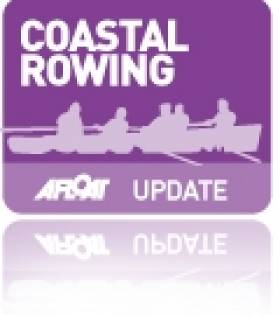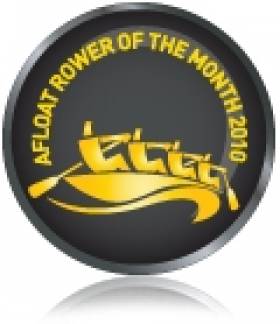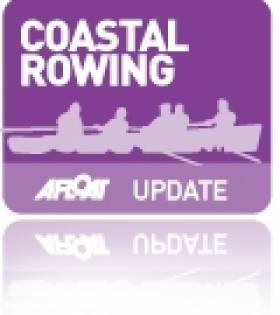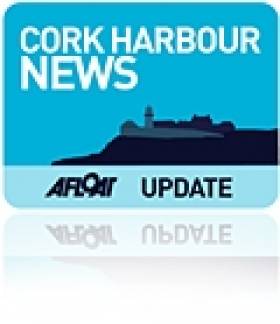Displaying items by tag: rowing
Portora/Ireland Quadruple are Rowers of Month
The Rowing Ireland/Portora composite which won the elite quadruple sculls at Henley Women’s Regatta are the Afloat Rowers of the Month for June. The crew of Eimear Moran, Lisa Dilleen, Holly Nixon and Sanita Puspure beat a British combination crew in the final by four lengths. Dilleen and Puspure had earlier won the elite double sculls.
Rower of the Month awards: The judging panel is made up of Liam Gorman, rowing correspondent of The Irish Times, President of Rowing Ireland Anthony Dooley and David O'Brien, Editor of Afloat magazine. Monthly awards for achievements during the year will appear on afloat.ie and the overall national award will be presented to the person or crew who, in the judges' opinion, achieved the most notable results in, or made the most significant contribution to rowing during 2011. Keep a monthly eye on progress and watch our 2011 champions list grow.
Rower Calls a Halt to Atlantic Crossing
An Irish rower last week cut short his attempt to cross the Atlantic from Newfoundland to Ireland.
Sean Moriarty told CBC News that he called for a rescue after two days at sea when his boat was flipped repeatedly in four-metre waves, damaging his electronic equipment.
Moriarty and his boat - the unfortunately named Positive Outcome - were picked up by a Canadian coastguard vessel and towed to St John's in Newfoundland on 13 June.
The Dingle native, who runs a construction firm, plans to ship his boat back home to Ireland.
Rower of the Month: Sanita Puspure Podcast
The Afloat Rowers of the Month for May, Sanita Puspure and Lisa Dilleen, showed how a new crew can knit together successfully: their first three results as a double scull were third, second and fifth – in the heats, semi-finals and finals at the World Cup regatta in Munich! Listen to Sanita Puspure talk about this on the Afloat Podcast (two minutes duration) here.
Dilleen and Puspure Award-Winning Double Rowers
The Ireland women’s double scull of Lisa Dilleen and Sanita Puspure are the Afloat Rowers of the Month for May. Despite being a new crew, formed in the weeks running up to the regatta, Dilleen and Puspure performed remarkably well at the World Cup in Munich. They finished second in their semi-final on Saturday and fifth in Sunday’s A Final. They are deserving winners of the Afloat Rowers of the Month award.
Rower of the Month awards: The judging panel is made up of Liam Gorman, rowing correspondent of The Irish Times, President of Rowing Ireland Anthony Dooley and David O'Brien, Editor of Afloat magazine. Monthly awards for achievements during the year will appear on afloat.ie and the overall national award will be presented to the person or crew who, in the judges' opinion, achieved the most notable results in, or made the most significant contribution to rowing during 2011. Keep a monthly eye on progress and watch our 2011 champions list grow.
Coastal Rowing Swings Into Action In Ringsend
The coastal rowing season on the east coast of Ireland swings into action this Sunday with the Stella Maris regatta in Ringsend.
Metro Regatta Decision on Friday
The organisers of Metropolitan Rowing Regatta will post a decision tomorrow on whether to go ahead with the event. Strong winds are forecast for Blessington on Saturday. There is a huge entry, and Metro is set to serve as a selection event for the Ireland team for the Home Internationals. The team behind Metro have already laid a new course to deal with a very low water level and have had to repair damage done to the course by vandals.
Ocean to City, Cork Harbour's annual maritime festival, takes place this year from 3-12 June.
The yearly celebration of Cork’s maritime history and its unique harbour begins on Friday 3 June when members of the public can voyage through the city by kayak, enjoy the thrill of a sea safari trip around Cork Harbour or follow TG4’s Padraig Ó Duinnín as he presents a historical walking tour and talk on rowing in Cork.
The highlight of the festival, An Rás Mór, takes place on Saturday 4 June and will see boats of all sizes row 15 nautical miles from Crosshaven via Cork Harbour, Monkstown and Blackrock before finishing at the boardwalk in Lapps Quay in Cork.
Around 400 Irish and International rowers will compete in a diverse range of vessels including dragon boats, kayaks, currachs, Celtic long boats, Cornish pilot gigs and Irish coastal rowing boats.
Sunday 5 June will see a special 10km kayak race through the city centre. The Irish Naval Service flagship LE Orla will also offer free public tours, while Meitheal Mara will host a guided voyage around the island of Cork by a variety of small craft.
To mark the Cork Harbour School and Heritage Trails Weekend from from 9-11 June, a series of events highlighting the attractions of Cork Harbour, both water and land based, will take place.
Activities include a summer school on the theme of 'recreation in a working port', which will be held in the Port of Cork on Friday 10 June and opened by Minister for the Marine Simon Coveney.
For more details visit www.oceantocity.com.
Trip to Queen's Gives Skibbereen League Boost
Skibbereen head the Grand League table after the second round. The west Cork club, who were in second place behind UCD after their own regatta, travelled to Castlewellan in Co Down for the Queen’s regatta last weekend and added sufficient points to build up a 132-point lead over second-placed Commercial. UCD, who did not travel to Queen’s, are tied with St Michael’s in joint third, just one point behind Commercial.
See Full Table Below
| Overall | After Skibbereen and Queens Regattas 2011 | Points |
|---|---|---|
| 1 | Skibbereen RC | 320 |
| 2 | Commercial RC | 188 |
| 3 | St. Michaels Rowing Club | 187 |
| 3 | U.C.D. BC | 187 |
| 5 | Neptune RC | 183 |
| 6 | Queens University Belfast BC | 118 |
| 7 | Shandon BC | 107 |
| 8 | Dublin University Ladies BC | 106 |
| 9 | Portora Boat Club | 102 |
| 10 | Cork BC | 92 |
| 11 | Bann RC | 89 |
| 11 | Queens University Belfast Ladies BC | 89 |
| 13 | NUI Galway BC | 82 |
| 14 | Methodist College RC | 79 |
| 16 | Carrick-on-Shannon RC | 64 |
| 17 | Dublin University BC | 63 |
| 18 | Muckross RC | 53 |
| 19 | Shannon RC | 51 |
| 20 | U.C.C. RC | 49 |
| 21 | University of Limerick RC | 47.5 |
| 22 | Carlow RC | 46 |
| 23 | St. Josephs College RC | 43 |
| 24 | Fermoy RC | 40 |
| 25 | Three Castles Rowing Club | 38 |
| 26 | Clonmel RC | 32 |
| 27 | Coleraine Academical Institution Boat Club | 30 |
| 28 | Athlunkard BC | 29 |
| 28 | Lee RC | 29 |
| 30 | R.B.A.I. Rowing Club | 28 |
| 31 | Galway RC | 20 |
| 31 | Old Collegians BC | 20 |
| 33 | Killorglin RC | 18.5 |
| 34 | Cappoquin | 17 |
| 34 | Tralee RC | 17 |
| 36 | Fossa RC | 16 |
| 37 | Garda Siochana BC | 14 |
| 38 | Belfast RC | 12 |
| 38 | Colaiste Chiarain RC | 12 |
| 38 | Lee Valley RC | 12 |
| 38 | Workmens RC | 12 |
| 42 | Lagan Scullers Club | 11 |
| 43 | Presentation College RC | 10 |
| 44 | Graiguenamanagh BC | 9 |
| 45 | Lady Elizabeth BC | 8 |
| 46 | Offaly RC | 6 |
| 47 | Grainne Mhaol RC | 4 |
| 48 | Portadown BC | 2 |
| 49 | Castleconnell BC | 1 |
| Mens Division 1 | After Skibbereen and Queens Regattas 2011 | Points |
| 1 | Skibbereen RC | 142 |
| 2 | Queens University Belfast BC | 83 |
| 3 | U.C.D. BC | 74 |
| 4 | Neptune RC | 71 |
| 5 | Commercial RC | 48 |
| 6 | Portora Boat Club | 37 |
| 7 | Dublin University BC | 30 |
| 8 | Carlow RC | 28 |
| 9 | Methodist College RC | 25 |
| 10 | Lee RC | 24 |
| 11 | Cork BC | 22 |
| 11 | NUI Galway BC | 22 |
| 13 | Bann RC | 21 |
| 13 | Muckross RC | 21 |
| 15 | St. Josephs College RC | 17 |
| 15 | University of Limerick RC | 17 |
| 17 | Fossa RC | 16 |
| 17 | R.B.A.I. Rowing Club | 16 |
| 19 | St. Michaels Rowing Club | 15 |
| 20 | Coleraine Academical Institution Boat Club | 14 |
| 20 | Three Castles Rowing Club | 14 |
| 22 | Lee Valley RC | 12 |
| 22 | Shandon BC | 12 |
| 24 | Carrick-on-Shannon RC | 10 |
| 24 | Presentation College RC | 10 |
| 26 | Belfast RC | 8 |
| 26 | Lady Elizabeth BC | 8 |
| 28 | Garda Siochana BC | 6 |
| 28 | U.C.C. RC | 6 |
| 30 | Workmens RC | 5 |
| 31 | Grainne Mhaol RC | 4 |
| 32 | Clonmel RC | 1 |
| Mens Division 2 | After Skibbereen and Queens Regattas 2011 | Points |
| 1 | St. Michaels Rowing Club | 89 |
| 2 | Neptune RC | 76 |
| 3 | Skibbereen RC | 51 |
| 4 | Commercial RC | 36 |
| 4 | Methodist College RC | 36 |
| 6 | Queens University Belfast BC | 35 |
| 7 | Bann RC | 34 |
| 8 | Cork BC | 33 |
| 8 | Dublin University BC | 33 |
| 10 | Portora Boat Club | 27 |
| 10 | U.C.D. BC A | 27 |
| 12 | St. Josephs College RC | 26 |
| 13 | Shannon RC | 24 |
| 14 | Shandon BC | 23 |
| 14 | U.C.C. RC | 23 |
| 16 | Fermoy RC | 21 |
| 17 | Athlunkard BC | 17 |
| 18 | Coleraine Academical Institution Boat Club | 16 |
| 19 | Carlow RC | 12 |
| 19 | Carrick-on-Shannon RC | 12 |
| 19 | R.B.A.I. Rowing Club | 12 |
| 22 | Cappoquin RC | 11 |
| 22 | Lagan Scullers Club | 11 |
| 22 | University of Limerick RC | 11 |
| 25 | Tralee RC | 9 |
| 26 | Workmens RC | 7 |
| 27 | Clonmel RC | 6 |
| 27 | Graiguenamanagh BC | 6 |
| 27 | NUI Galway BC | 6 |
| 30 | Lee RC | 5 |
| 31 | Colaiste Chiarain RC | 4 |
| 32 | Muckross RC | 1 |
| Womens Division 1 | After Skibbereen and Queens Regattas 2011 | Points |
| 1 | Skibbereen RC | 127 |
| 2 | St. Michaels Rowing Club | 71 |
| 3 | U.C.D. BC | 70 |
| 4 | Dublin University Ladies BC | 59 |
| 5 | Queens University Belfast Ladies BC | 44 |
| 6 | Shandon BC | 40 |
| 7 | Neptune RC | 36 |
| 8 | NUI Galway BC | 29 |
| 8 | Portora Boat Club | 29 |
| 10 | Three Castles Rowing Club | 24 |
| 11 | Bann RC | 23 |
| 11 | Muckross RC | 23 |
| 13 | Old Collegians BC | 20 |
| 14 | Carrick-on-Shannon RC | 19 |
| 14 | Commercial RC | 19 |
| 16 | Killorglin RC | 14.5 |
| 17 | University of Limerick RC | 9.5 |
| 18 | Clonmel RC | 9 |
| 18 | Cork BC | 9 |
| 20 | Methodist College RC | 8 |
| 21 | Offaly RC | 6 |
| 22 | Belfast RC | 4 |
| 23 | Portadown BC | 2 |
| 24 | Athlunkard BC | 1 |
| Womens Division 2 | After Skibbereen and Queens Regattas 2011 | Points |
| 1 | Commercial RC | 85 |
| 2 | Dublin University Ladies BC | 47 |
| 3 | Queens University Belfast Ladies BC | 45 |
| 4 | Shandon BC | 33 |
| 5 | Cork BC | 28 |
| 6 | Shannon RC | 27 |
| 7 | NUI Galway BC | 25 |
| 7 | U.C.D. BC | 25 |
| 9 | Carrick-on-Shannon RC | 23 |
| 10 | Galway RC | 20 |
| 11 | Fermoy RC | 19 |
| 12 | Clonmel RC | 16 |
| 13 | St. Michaels Rowing Club | 12 |
| 14 | Athlunkard BC | 11 |
| 14 | Bann RC | 11 |
| 14 | U.C.C. RC | 11 |
| 17 | Methodist College RC | 10 |
| 17 | University of Limerick RC | 10 |
| 19 | Portora Boat Club | 9 |
| 20 | Colaiste Chiarain | 8 |
| 20 | Garda Siochana BC | 8 |
| 20 | Muckross RC | 8 |
| 20 | Tralee RC | 8 |
| 24 | Cappoquin | 6 |
| 24 | Carlow RC | 6 |
| 26 | Killorglin RC | 4 |
| 27 | Graiguenamanagh | 3 |
| 28 | Castleconnell BC | 1 |
Rowing updates from Ghent, Essen and Munich
Colaiste Iognaid Do Well at Ghent
Colaiste Iognaid’s junior men’s eight finished second in their class at the Ghent rowing regatta in Belgium. An Irish crew, Cork Boat Club, also won the junior women’s eight – but this was a certainty. The three crews competing were all Irish – a Methody/Offaly combination was second and Colaiste Iognaid were third.
Ghent Regatta, Belgium , Day One - Selected Results (Irish interest)
Men
Eight – Junior: 1 Willem III, Amsterdam 7:05.69, 2 Col Iognaid 7:25.04.
Four – Junior, coxed: 2 Col Iognaid 7:44.97.
Quadruple – Junior: 6 Offaly.
Single – Lightweight: 3 Cork (D Murphy) 8:10.68.
Women
Eight – Junior: 1 Cork 7:53.02, 2 Methodist/Offaly 8:38.55, 3 Col Iognaid 8:50.64.
Four – Junior: 2 Cork (L Murphy, C Deasy, K Mackey, S Higgins) 8:10.02.
Sculling, Quadruple – Junior: 6 Cork 8:02.22
Single – Lightweight: 2 Three Castles (B Quinn) 9:09.31.






































































